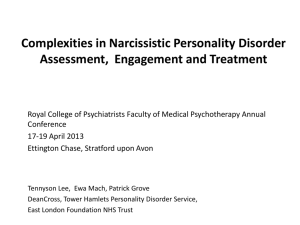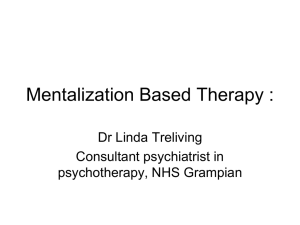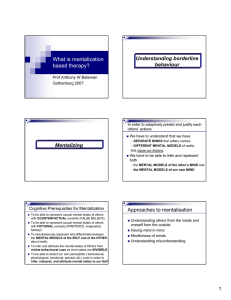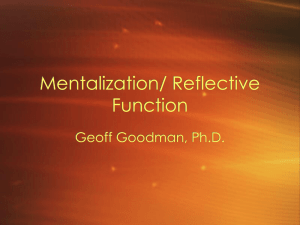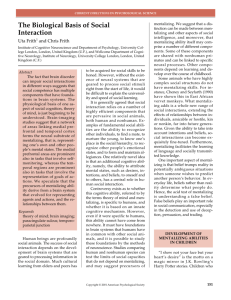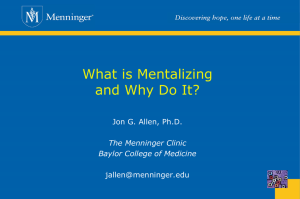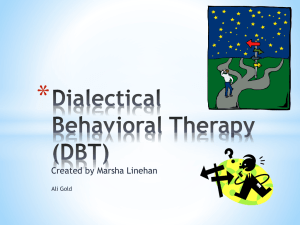The role of child and parent mentalizing for the
advertisement
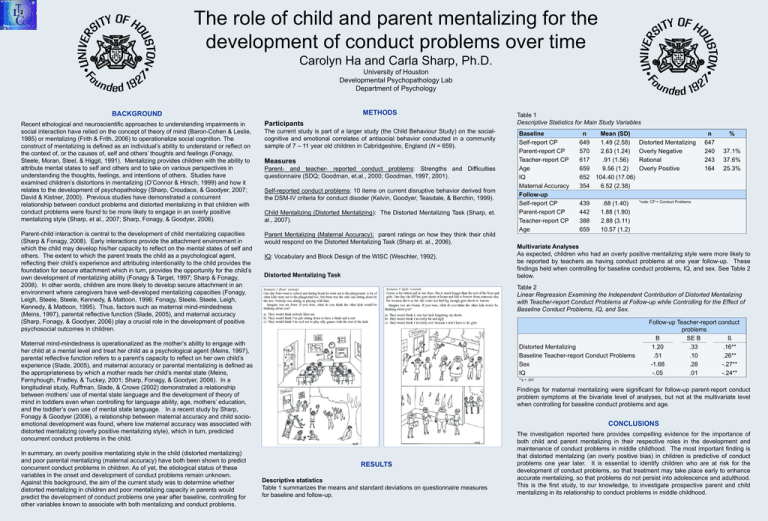
The role of child and parent mentalizing for the development of conduct problems over time Carolyn Ha and Carla Sharp, Ph.D. University of Houston Developmental Psychopathology Lab Department of Psychology METHODS BACKGROUND Recent ethological and neuroscientific approaches to understanding impairments in social interaction have relied on the concept of theory of mind (Baron-Cohen & Leslie, 1985) or mentalizing (Frith & Frith, 2006) to operationalize social cognition. The construct of mentalizing is defined as an individual’s ability to understand or reflect on the context of, or the causes of, self and others’ thoughts and feelings (Fonagy, Steele, Moran, Steel, & Higgit, 1991). Mentalizing provides children with the ability to attribute mental states to self and others and to take on various perspectives in understanding the thoughts, feelings, and intentions of others. Studies have examined children’s distortions in mentalizing (O’Connor & Hirsch, 1999) and how it relates to the development of psychopathology (Sharp, Croudace, & Goodyer, 2007; David & Kistner, 2000). Previous studies have demonstrated a concurrent relationship between conduct problems and distorted mentalizing in that children with conduct problems were found to be more likely to engage in an overly positive mentalizing style (Sharp, et al., 2007; Sharp, Fonagy, & Goodyer, 2006). Parent-child interaction is central to the development of child mentalizing capacities (Sharp & Fonagy, 2008). Early interactions provide the attachment environment in which the child may develop his/her capacity to reflect on the mental states of self and others. The extent to which the parent treats the child as a psychological agent, reflecting their child’s experience and attributing intentionality to the child provides the foundation for secure attachment which in turn, provides the opportunity for the child’s own development of mentalizing ability (Fonagy & Target, 1997; Sharp & Fonagy, 2008). In other words, children are more likely to develop secure attachment in an environment where caregivers have well-developed mentalizing capacities (Fonagy, Leigh, Steele, Steele, Kennedy, & Mattoon, 1996; Fonagy, Steele, Steele, Leigh, Kennedy, & Mattoon, 1995). Thus, factors such as maternal mind-mindedness (Meins, 1997), parental reflective function (Slade, 2005), and maternal accuracy (Sharp, Fonagy, & Goodyer, 2006) play a crucial role in the development of positive psychosocial outcomes in children. Participants The current study is part of a larger study (the Child Behaviour Study) on the socialcognitive and emotional correlates of antisocial behavior conducted in a community sample of 7 – 11 year old children in Cabridgeshire, England (N = 659). Measures Parent- and teacher- reported conduct problems: Strengths and Difficulties questionnaire (SDQ; Goodman, et.al., 2000; Goodman, 1997, 2001). Self-reported conduct problems: 10 items on current disruptive behavior derived from the DSM-IV criteria for conduct disoder (Kelvin, Goodyer, Teasdale, & Berchin, 1999). Child Mentalizing (Distorted Mentalizing): The Distorted Mentalizing Task (Sharp, et. al., 2007). Parent Mentalizing (Maternal Accuracy): parent ratings on how they think their child would respond on the Distorted Mentalizing Task (Sharp et. al., 2006). IQ: Vocabulary and Block Design of the WISC (Weschler, 1992). Distorted Mentalizing Task Baseline Self-report CP Parent-report CP Teacher-report CP Age IQ Maternal Accuracy Follow-up Self-report CP Parent-report CP Teacher-report CP Age n Mean (SD) 649 1.49 (2.58) 570 2.63 (1.24) 617 .91 (1.56) 659 9.56 (1.2) 652 104.40 (17.06) 354 6.52 (2.38) 439 442 388 659 .68 (1.40) 1.88 (1.90) 2.88 (3.11) 10.57 (1.2) Distorted Mentalizing Overly Negative Rational Overly Positive n 647 240 243 164 % 37.1% 37.6% 25.3% *note: CP = Conduct Problems Multivariate Analyses As expected, children who had an overly positive mentalizing style were more likely to be reported by teachers as having conduct problems at one year follow-up. These findings held when controlling for baseline conduct problems, IQ, and sex. See Table 2 below. Table 2 Linear Regression Examining the Independent Contribution of Distorted Mentalizing with Teacher-report Conduct Problems at Follow-up while Controlling for the Effect of Baseline Conduct Problems, IQ, and Sex. Maternal mind-mindedness is operationalized as the mother’s ability to engage with her child at a mental level and treat her child as a psychological agent (Meins, 1997), parental reflective function refers to a parent’s capacity to reflect on her own child’s experience (Slade, 2005), and maternal accuracy or parental mentalizing is defined as the appropriateness by which a mother reads her child’s mental state (Meins, Fernyhough, Fradley, & Tuckey, 2001; Sharp, Fonagy, & Goodyer, 2006). In a longitudinal study, Ruffman, Slade, & Crowe (2002) demonstrated a relationship between mothers’ use of mental state language and the development of theory of mind in toddlers even when controlling for language ability, age, mothers’ education, and the toddler’s own use of mental state language. In a recent study by Sharp, Fonagy & Goodyer (2006), a relationship between maternal accuracy and child socioemotional development was found, where low maternal accuracy was associated with distorted mentalizing (overly positive mentalizing style), which in turn, predicted concurrent conduct problems in the child. In summary, an overly positive mentalizing style in the child (distorted mentalizing) and poor parental mentalizing (maternal accuracy) have both been shown to predict concurrent conduct problems in children. As of yet, the etiological status of these variables in the onset and development of conduct problems remain unknown. Against this background, the aim of the current study was to determine whether distorted mentalizing in children and poor mentalizing capacity in parents would predict the development of conduct problems one year after baseline, controlling for other variables known to associate with both mentalizing and conduct problems. Table 1 Descriptive Statistics for Main Study Variables Distorted Mentalizing Baseline Teacher-report Conduct Problems Sex IQ Follow-up Teacher-report conduct problems B SE B ß 1.20 .33 .16** .51 .10 .26** -1.68 .28 -.27** -.05 .01 -.24** **p < .001 Findings for maternal mentalizing were significant for follow-up parent-report conduct problem symptoms at the bivariate level of analyses, but not at the multivariate level when controlling for baseline conduct problems and age. CONCLUSIONS RESULTS Descriptive statistics Table 1 summarizes the means and standard deviations on questionnaire measures for baseline and follow-up. The investigation reported here provides compelling evidence for the importance of both child and parent mentalizing in their respective roles in the development and maintenance of conduct problems in middle childhood. The most important finding is that distorted mentalzing (an overly positive bias) in children is predictive of conduct problems one year later. It is essential to identify children who are at risk for the development of conduct problems, so that treatment may take place early to enhance accurate mentalizing, so that problems do not persist into adolescence and adulthood. This is the first study, to our knowledge, to investigate prospective parent and child mentalizing in its relationship to conduct problems in middle childhood.


